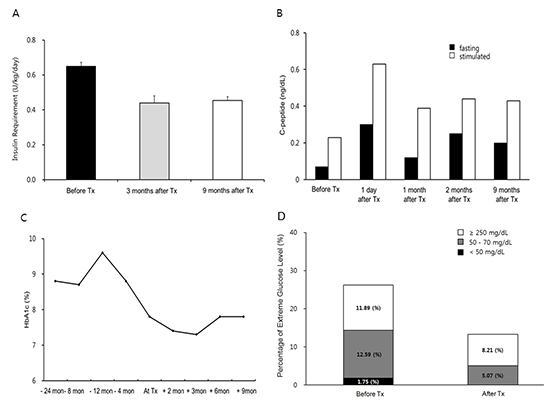1. Shapiro AM, Ricordi C, Hering BJ, Auchincloss H, Lindblad R, Robertson RP, Secchi A, Brendel MD, Berney T, Brennan DC, et al. International trial of the Edmonton protocol for islet transplantation. N Engl J Med. 2006; 355:1318–1330.
2. Goss JA, Schock AP, Brunicardi FC, Goodpastor SE, Garber AJ, Soltes G, Barth M, Froud T, Alejandro R, Ricordi C. Achievement of insulin independence in three consecutive type-1 diabetic patients via pancreatic islet transplantation using islets isolated at a remote islet isolation center. Transplantation. 2002; 74:1761–1766.
3. Yang TY, Oh SH, Jeong IK, Seo IA, Oh EY, Kim SJ, Chung JH, Min YK, Lee MS, Lee MK, et al. First human trial of pancreatic islet allo-transplantation in Korea--focus on re-transplantation. Diabetes Res Clin Pract. 2002; 56:107–113.
4. Lee BW, Jee JH, Heo JS, Choi SH, Jang KT, Noh JH, Jeong IK, Oh SH, Ahn YR, Chae HY, et al. The favorable outcome of human islet transplantation in Korea: experiences of 10 autologous transplantations. Transplantation. 2005; 79:1568–1574.
5. Shapiro AM, Lakey JR, Ryan EA, Korbutt GS, Toth E, Warnock GL, Kneteman NM, Rajotte RV. Islet transplantation in seven patients with type 1 diabetes mellitus using a glucocorticoid-free immunosuppressive regimen. N Engl J Med. 2000; 343:230–238.
6. Hill NR, Hindmarsh PC, Stevens RJ, Stratton IM, Levy JC, Matthews DR. A method for assessing quality of control from glucose profiles. Diabet Med. 2007; 24:753–758.
7. Park SA, Ko SH, Lee SH, Cho JH, Moon SD, Jang SA, Song KH, Son HS, Yoon KH, Cha BY, et al. Average daily risk range-index of glycemic variability-related factor in type 2 diabetic inpatients. Korean Diabetes J. 2009; 33:31–39.
8. Kovatchev BP, Otto E, Cox D, Gonder-Frederick L, Clarke W. Evaluation of a new measure of blood glucose variability in diabetes. Diabetes Care. 2006; 29:2433–2438.
10. Anazawa T, Matsumoto S, Yonekawa Y, Loganathan G, Wilhelm JJ, Soltani SM, Papas KK, Sutherland DE, Hering BJ, Balamurugan AN. Prediction of pancreatic tissue densities by an analytical test gradient system before purification maximizes human islet recovery for islet autotransplantation/allotransplantation. Transplantation. 2011; 91:508–514.
11. Hering BJ, Kandaswamy R, Ansite JD, Eckman PM, Nakano M, Sawada T, Matsumoto I, Ihm SH, Zhang HJ, Parkey J, et al. Single-donor, marginal-dose islet transplantation in patients with type 1 diabetes. Jama. 2005; 293:830–835.






 PDF
PDF ePub
ePub Citation
Citation Print
Print




 XML Download
XML Download